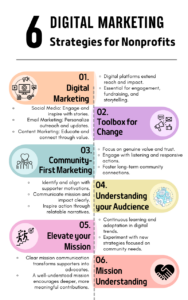In an era where digital presence is more than just a luxury, nonprofits are increasingly recognizing the necessity of a robust digital marketing strategy. With the digital landscape evolving rapidly, staying informed on the latest trends and tools is crucial for organizations aiming to maximize their impact. Through strategic use of digital tools and a deep understanding of community engagement, nonprofits can significantly enhance their outreach and effectiveness.
The indispensable need for a Digital Marketing strategy
First and foremost, does your nonprofit need a digital marketing strategy? Absolutely. In today’s interconnected world, digital marketing is not just an option; it’s a critical component of any organization’s outreach and engagement efforts. It enables nonprofits to reach wider audiences, engage with stakeholders more effectively, and drive their missions forward with greater impact. A well-crafted digital marketing strategy can enhance visibility, boost fundraising efforts, and foster a sense of community and belonging among supporters.

Leveraging Digital Marketing tools: A nonprofit perspective
Nonprofits are uniquely positioned to leverage digital marketing tools to not only tell their stories but also to mobilize support, drive donations, and engage with their communities on a deeper level. From social media platforms to email marketing and content marketing, these tools offer many ways to reach and resonate with potential donors and volunteers. The use of analytics and data-driven strategies enables nonprofits to tailor their messages and campaigns to meet the specific interests and needs of their audience, ensuring that every communication is impactful and meaningful.
The importance of community-first Marketing
One of the most compelling aspects of this type of Marketing strategy is the emphasis on community-first marketing. This approach prioritizes building and nurturing relationships with the community at the heart of the nonprofit’s mission. It’s about creating value and fostering connections that go beyond transactional interactions. By focusing on community engagement, nonprofits can create a loyal base of supporters who are not only willing to donate but also advocate for the organization’s cause.
Community-first marketing also involves listening to and understanding the needs and preferences of the community. This insight allows nonprofits to tailor their messages and campaigns to resonate more deeply with their audience, thereby enhancing the effectiveness of their digital marketing efforts.
Understanding your audience: The key to inspiring action
The success of any digital marketing strategy ultimately hinges on the organization’s ability to connect with its audience on a personal and emotional level. The audience’s understanding of the nonprofit’s purpose and mission is crucial. When people feel a deep connection to the cause and clearly understand how their support can make a difference, they are more likely to take action.
Transparency, storytelling, and authentic engagement are vital components of this understanding. Through compelling narratives and open communication, nonprofits can illustrate the impact of their work, the challenges they face, and the victories they achieve. This not only educates the audience but also inspires them to become part of the solution.
They need to “Feel” your mission
Understanding the nonprofit’s mission is a cornerstone of any successful digital marketing strategy. It’s not just about broadcasting a message; it’s about forging a connection that inspires action. When the audience truly understands the purpose and the tangible impact of their support, engagement transitions from passive to passionate. This deep understanding fuels a sense of ownership and commitment among supporters, transforming them from occasional donors to ardent advocates. Therefore, articulating the mission in a clear, compelling manner across all digital platforms is important. It’s about painting a vivid picture of the change that the nonprofit seeks to create in the world and illustrating how every contribution brings us closer to that vision. By making the mission relatable and the outcomes tangible, nonprofits can harness the power of digital marketing to not only reach but resonate with their audience, cultivating a community of informed, motivated supporters.
The path forward with Digital Marketing
For nonprofits ready to harness the power of digital marketing, the journey involves continuous learning and adaptation. The digital world is ever-changing, with new trends, tools, and tactics emerging regularly. Staying informed and agile, willing to experiment with new strategies while keeping the community’s needs at the forefront, is essential for sustained success.
In conclusion, the need for a dynamic and responsive digital marketing strategy in the nonprofit sector has never been more critical. As organizations strive to navigate the complexities of the digital age, the principles of community engagement, audience understanding, and strategic use of digital tools will be key drivers of success. Let’s embrace these challenges and opportunities as we work towards a more connected, engaged, and impactful nonprofit community.
